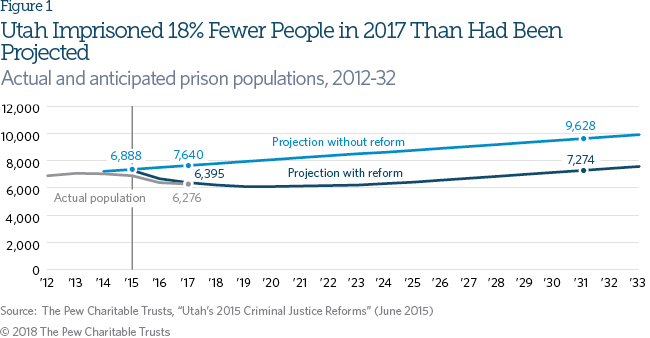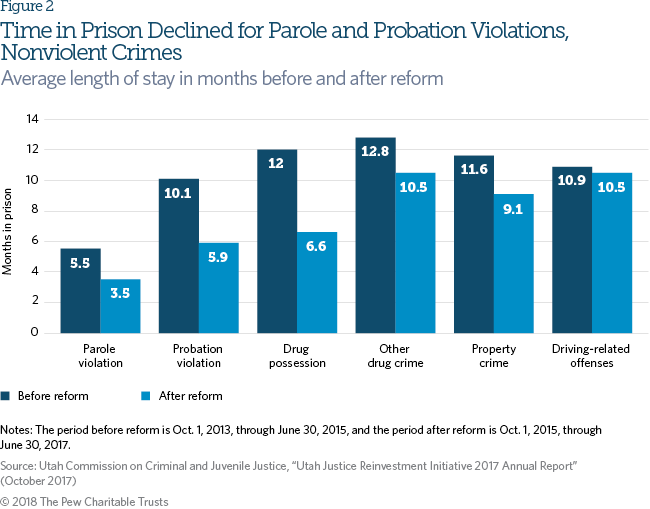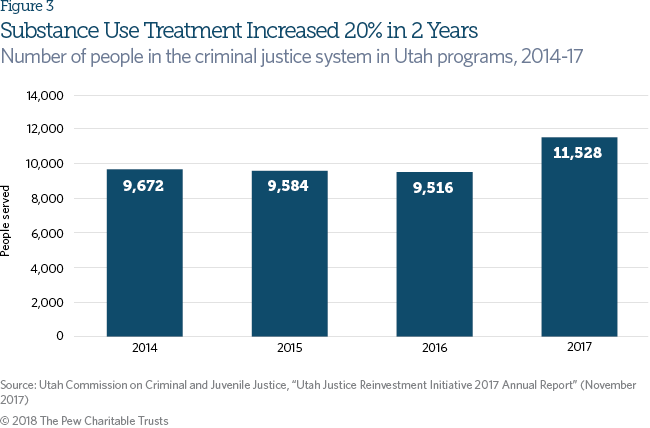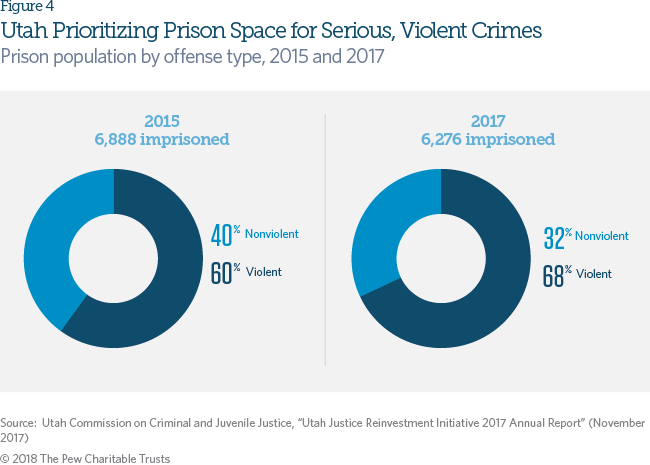Data Trends: Utah Criminal Justice Reform
After bipartisan law passed in 2015, state’s prison population dropped 9%
From 2004 to 2013, Utah’s prison population rose by 19 percent, five times the national average. Without changes to policies and practices, the state projected additional growth of 37 percent at a cost to taxpayers of $500 million over 20 years. Seeking to safely reverse this trend, lawmakers passed comprehensive criminal justice reform in 2015. The law prioritized prison space for people convicted of serious and violent offenses, strengthened community supervision, improved and expanded re-entry and treatment services, and provided oversight of the legislation’s implementation.1 Since then, the state has reinvested over $35 million in evidencebased treatment and other alternatives to incarceration, and its prison population has declined.2 The state’s overall crime rate decreased 13 percent in the decade before the legislation was passed (2006-15) and continued to fall in the first year after reform (2016), dropping another 1 percent.3
Prison population reduced
- Utah’s prison population dropped by 9 percent from 2015 to 2017.4
- The average daily population in 2017 was 18 percent less than was projected without reforms, and all anticipated prison growth had been avoided.5
- The number of people sentenced to prison for nonviolent offenses declined 30 percent.6
- The share of prison space prioritized for people convicted of violent offenses rose from 60 percent to 68 percent.7
Imprisonment for targeted offenses declined
- The share of the prison population that was convicted of drug possession dropped from 5 percent in 2015 to 2 percent in 2017.8
- The length of time spent behind bars for drug possession fell from an average of one year before reform (Oct. 1, 2013, to June 30, 2015) to 6.6 months after reform (Oct. 1, 2015, to June 30, 2017).9
- Over the same period, the length of time spent in prison for property offenses decreased by 2.5 months.10
Treatment resources increased
- The number of people in the criminal justice system who were admitted to substance use treatment increased by 20 percent from 2015 to 2017.11
- The number in residential treatment increased by 29 percent.12
- The number of outpatient clients grew by 4 percent.13
Taxpayer dollars saved
- Utah expects to save an estimated $500 million through averted spending and reduced operating costs by 2034.14
- The state had reinvested more than $35 million in treatment and evidence-based alternatives to prison by the end of 2017.15
Background
In March 2015, the Utah Legislature passed H.B. 348, a set of sentencing and corrections reforms based on recommendations from the Commission on Criminal and Juvenile Justice, with overwhelming majorities in both chambers.16The commission consulted a variety of stakeholders and received technical assistance from The Pew Charitable Trusts and the Crime and Justice Institute (CJI) as part of the Justice Reinvestment Initiative, a publicprivate partnership that includes Pew, CJI, the U.S. Justice Department’s Bureau of Justice Assistance, the Council of State Governments, and other organizations.
The next year, the state adopted comprehensive juvenile justice reforms that are projected to reduce the population of juveniles placed in state custody by 47 percent and to yield more than $70 million for reinvestment in evidence-based alternatives to incarceration.17The commission continues to oversee the reforms, monitoring progress and proposing additional improvements.
Endnotes
- The Pew Charitable Trusts, “Utah’s 2015 Criminal Justice Reforms” (June 2015), http://www.pewtrusts.org/en/research-and-analysis/issue-briefs/2015/06/utahs-2015-criminal-justice-reforms.
- Presentation by Utah Commission on Criminal and Juvenile Justice, “Utah Justice Reinvestment Initiative—JRI, Second Annual JRI Report—Highlights” (October 2017), slide 4, https://justice.utah.gov/Documents/CCJJ/Justice Reinvestment Initiative/JRI 2017 Annual Report.pdf.
- FBI Uniform Crime Reporting, “Crime in the United States, by State, 2006,” https://www2.fbi.gov/ucr/cius2006/data/table_05.html; FBI Uniform Crime Reporting, “Crime in the United States, by State, 2015,” https://ucr.fbi.gov/crime-in-the-u.s/2015/crime-in-the-u.s.-2015/tables/table-5; FBI Uniform Crime Reporting, “Crime in the United States, by State, 2016,” https://ucr.fbi.gov/crime-in-the-u.s/2016/crime-in-the-u.s.-2016/tables/table-3.
- Utah Commission on Criminal and Juvenile Justice, “Utah Justice Reinvestment Initiative 2017 Annual Report” (October 2017), https://justice.utah.gov/Documents/CCJJ/Justice Reinvestment Initiative/JRI 2017 Annual Report.pdf.
- Ibid.
- Ibid.
- Ibid.
- Ibid.
- Ibid.
- Ibid.
- Ibid.
- Ibid.
- Ibid.
- The Pew Charitable Trusts, “Utah’s 2015 Criminal Justice Reforms.”
- Presentation by Utah Commission on Criminal and Juvenile Justice.
- The Pew Charitable Trusts, “Bipartisan Support for Justice Reinvestment Legislation” (June 2015), http://www.pewtrusts.org/en/multimedia/data-visualizations/2015/bipartisan-support-for-justice-reinvestment-legislation.
- The Pew Charitable Trusts, “Pew Applauds Utah for Comprehensive Juvenile Justice Reform” (April 2017), http://www.pewtrusts.org/en/about/news-room/press-releases/2017/04/21/pew-applauds-utah-for-comprehensive-juvenile-justice-reform.











